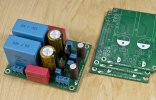D
Deleted member 48726
Guest
Also M3 (I think?) having many problems with defective display as well. And you need the display to be able to navigate the menu for tone controls etc.Yes and I get tired of having to explain it every single time. NAD is built with the cheapest possible electrolytics, very often placed strategically close to heatsinks to shorten their lifespan even further so that the device breaks down. These devices are built to fail, guaranteed. Same goes for resistors for example, mostly undersized which results in high operating temperatures.
I've had about 15 NAD amps from the last 30 years here, same trash all the time. Just to tell you a few: C352BEE wrong transformer because they were lazy and took a transformer from a bigger model having to drop the voltage quite drastically over resistors, therefore you get extremely hot parts that fail. C370 has class-A modules enclosed in cans running hot and which contain tiny electrolytics (again C-tier chinese caps), every one fails, I serviced them. C375BEE same story, undersized parts, drivers run extremely hot, electrolytics fail, atrocious soldering quality.
The Masters series is no better, runs hot and fails quickly.
The 90's models have decent caps (a mix of A/B tier like Elna + TEAPO) but suffer from corrosive glue while they already KNEW that glue will be eating components over time as it did with Sansui.





